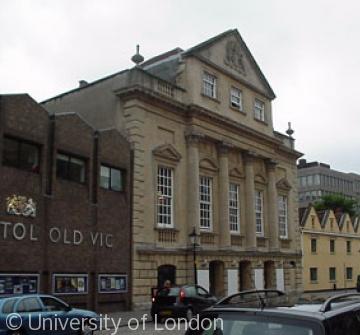Theatre Royal

The Theatre Royal is situated on the quiet cobbled King Street . It is claimed to be Britain's second oldest working theatre and was set up in this street because land here was cheap. It was built to designs by Thomas Paty between 1764 and 1766 and was paid for by a group of businessmen, many of whom were involved in the slave trade or in slave plantations.
The interior was modelled, with some variations, on that of the Drury Lane Theatre Royal in London. The first performance, on 30 May 1766, included a prologue and epilogue by David Garrick. However, the theatre was initially unable to obtain a Royal Licence, and had to advertise its productions as "a concert with a specimen of rhetorick" to avoid prosecution under the Licensing Act 1737. This pretence was dropped after two years, though a touring production playing in the Coopers' Hall in 1773 did run into legal trouble.
The auditorium was remodelled with a new sloping ceiling and gallery in 1800. The theatre was managed by William M'Cready from 1819 with little success, but slowly rose again under his widow Sarah M'Cready in the 1850s. After her death in 1853 the M'Creadys' son-in-law James Chute took over, but allowed the Theatre Royal to decline again when he opened the Prince's Theatre in 1867. A new, but still unsatisfactory, entranceway was constructed in 1903.
The threat of closure in 1942 led to a public appeal to preserve the historic theatre, and as a result a new Trust was established to buy the building. The Council for the Encouragement of Music and the Arts leased the building from the Trust and in 1946 CEMA's successor the Arts Council arranged for a company from the London Old Vic to staff it, thus forming the Bristol Old Vic. The Bristol Old Vic Theatre School was also established in 1946. The Bristol Old Vic had its greatest triumph when its 1954 production Salad Days transferred to the West End and became the longest-running musical on the London stage. The Arts Council remained involved until 1963 when their role was taken over by the City Council.
The present theatre complex, designed by Peter Moro, was completed in 1972. The entrance building was demolished, as were a number of surrounding buildings and, more controversially, the stage area of the 1766 theatre. A new stage and fly tower were built along with technical facilities and offices. The 150-seat New Vic Studio Theatre was built in place of the old entrance, and the Coopers' Hall provided the theatre with the grand façade and foyer area it had previously lacked.
Content generated during research for the paperback book 'Bristol: Ethnic Monorities and the City 1000-2001' (ISBN 13 : 978-1-86077-477-5 ) for the England's Past for Everyone series




